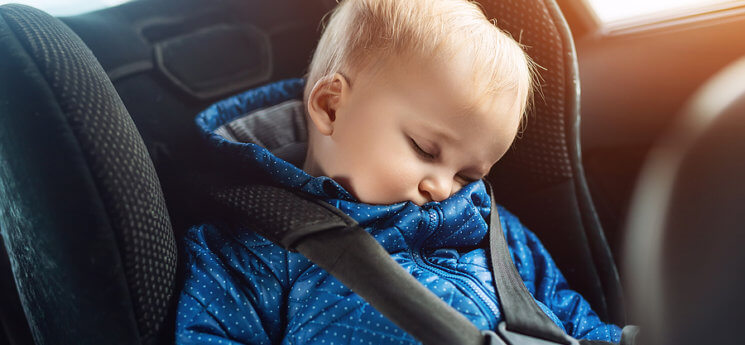I wasn’t surprised when my friend told me her sleep tip for traveling with a toddler—packing a suitcase full of her daughterʼs favorite stuffed animals. My family resembles a traveling caravan at airports as we transport all our gear. With young children, you have to be prepared. Last spring, our three-hour nonstop flight from Mexico turned into an 18-hour epic journey home to Chicago because of unexpected weather disasters.
With the advent of the holiday season, which often includes travel, here are my top sleep tips for traveling with babies and toddlers.
Plan travel time around sleep time.
Because toddlers are naturally excited, or even stimulated, by travel plans, itʼs often hard for them to sleep on the road or on an airplane. Try to plan your departure and arrival times around naps as much as possible. If your child still naps in the morning, plan to leave after the morning nap, not before. Remember the first nap is usually the most restorative and helps curb over-tiredness for the rest of the day. Also, transit naps are not as restful. As much as possible, plan to be at your destination by the usual bedtime.
Think ahead about sleeping conditions.
Going from having their own bedrooms to crowding everyone into one bedroom can spell disaster. If you plan to stay in a hotel, look for one of the growing number of suite inns to give you some extra living space with a pull out or a crib. Finding a condo or private home has become easier than ever with sites like VRBO and Kayak. Extra sleeping space makes for a more relaxed time for everyone.
Buy, rent or reserve the beds youʼll need.
A wise sleep tip for traveling with toddlers: If you stay with family on a regular basis, buy, or ask family members to borrow or rent, a portable crib. If you are staying in a hotel, call in advance, so the cribs or extra pull out beds will be ready when you check in. If youʼre traveling by car, BYOB, or bring your own bed; a pack ‘n’ play or travel bed or sleeping bags are great portable options.
Do practice runs.
Trips cause a lot of disruptions to familiar routines, whether itʼs at a hotel or your in-laws’ house. You donʼt want to arrive, only to have your child go into meltdown mode. If you take your own travel bed, allow your child to sleep in it a few nights before you leave, in order to get used to it. Also, talk with toddlers about the plans, including new sleeping arrangements, prior to take-off.
Take along helpful sleep accessories.
Have you ever packed a suitcase full of toys only to never unzip the bag? I have! But these days I have exchanged the extra toy bag for one with some helpful sleep accessories. Here are some lightweight options:
- A white noise app Download to your smartphone a white noise app, such as “Relax Melodies” which allows you to customize the sound.
- A favorite stuffed animal or lovey Choose one or two items your child wonʼt sleep without.
- Sheets Even when traveling without the crib, consider taking your own crib sheets. The familiar patterns, feel, and smell can help a child transition to a new sleeping environment. Tip: hotels (or even family) may not have appropriately-sized sheets, so itʼs better to take along your own.
- Black plastic bags and some painters’ tape They donʼt win any design awards, but garbage bags make great blackout “curtains” if you need them.
- Strollers: With travel more uncertain than ever, expect delays. Even toddlers old enough to walk easily may benefit from rest on wheels. Pushing a stroller is a whole lot easier than giving shoulder rides through the airport or amusement parks.
Recreate bedtime routines.
Despite changes of schedules and scenery, try to keep bedtime routines constant. If bath, books, and song are parts of your normal routine, stick to them. If Grandma or Uncle Bob want to participate, let them join in too.
Squeeze in naps as much as possible.
Whether walking through Disney World or spending time with your family, itʼs tempting to eliminate the nap. But skipping routine naps spells trouble! If your schedule necessitates a skipped nap one day, try to create a lighter schedule the next to allow for crucial day time rest. If you do miss a nap, compensate with an earlier bedtime.
The more the sleep deficit accumulates, the more you are heading for dreaded meltdowns-even if youʼre at the zoo! Be flexible, but accommodate the day time sleep needs as much as possible — even if it is limited to napping in the stroller or car or at the beach. When your child naps, take advantage of a midday siesta yourself! Itʼs a great fix for the whole family.
Anticipate time differences.
If you are traveling across time zones, allow a few days to get sleep back on track both when arriving or returning home. The best advice is to move your schedules to the new time zone as soon as possible. If you are only traveling for a few days across one or two time zones, it is sometimes easiest to stay on your home time zone. This decision may require earlier bedtimes and later wakings or vice versa.
Break some rules and have fun!
Try not to stress out about strict sleep habits on vacation. Kids are surprisingly resilient—if they miss a few naps and go to bed too late a few nights, they will survive. Let the kids have fun doing something they donʼt usually do. And if you disturb a few people-fellow passengers or other hotel visitors– along the way, you wonʼt see them again, so donʼt worry!
Get back on track as soon as you get home.
Sometimes the hardest part of a trip is to resume normal routines when you return. Staying up late eating popcorn at Grandmaʼs is so much more fun than hitting the hay at 7:00pm every night. But donʼt bring vacation habits home with you. Try to get back to nap and bedtime routines as soon as possible — knowing that it might take a few days and cause a few tears.
By Rebecca Kempton, M.D., Family Sleep Institute graduate and founder of Baby Sleep Pro, is a certified infant and toddler sleep consultant who helps parents develop sleep training skills to get their family’s sleep on the right path.




